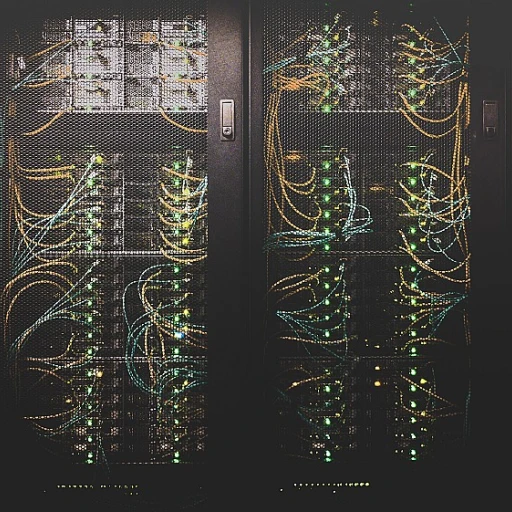
Understanding Continuous Integration
What is continuous integration?
Continuous Integration, commonly referred to as CI, is a development practice where developers frequently integrate code into a shared repository, multiple times a day. The core idea is to identify errors quickly and rectify them. This methodology facilitates the automation of testing and deployment processes, significantly alleviating the manual workload.
Eric Minick, DevOps evangelist at IBM, states, 'CI encourages a culture of regular code committing, ensuring that bugs and errors are quickly identified and resolved, enhancing overall software quality.'
A survey conducted by GitLab in 2021 revealed that 84% of developers practicing CI reported fewer bugs post-deployment, signifying CI's impact on software integrity and user satisfaction. GitHub Actions, Jenkins, and Travis CI are among the most popular CI tools influencing this shift towards automated, streamlined code integration.
When discussing the nitty-gritty of implementing CI (refer to the expert views section), remember its pivotal role in the agile development framework. Integrating CI fundamentally changes the approach to code management, making it a cornerstone in modern software development practices.
Exploring CI tools and technologies can shed more light on how they are effectively utilized in different setups.
Key Benefits of Continuous Integration
Improved code quality
One of the standout advantages of adopting Continuous Integration (CI) is the significant boost in code quality. According to a 2022 report by JetBrains, 78% of developers who utilize CI practices reported a noticeable improvement in the quality of their codebases. CI ensures that every code change is automatically tested, reducing the chances of bugs and errors making it to the production environment.
Accelerated development cycles
Incorporating CI can drastically shorten development cycles. A study by Martin Fowler highlighted that teams could increase their delivery speed by up to 50% with effective CI practices. This rapid feedback loop allows developers to identify and resolve issues in real-time, fostering a more agile development process.
Enhanced collaboration and communication
CI fosters a collaborative atmosphere within development teams. With every code change being continuously integrated into a shared repository, developers stay in sync, reducing integration problems and improving communication. A report from GitLab's 2021 Global Developer Survey stated that 65% of organizations saw improved team collaboration due to CI.
Reduced deployment risks
Deploying new features and updates can be risky, but CI mitigates these risks by offering a stable and tested integration process. According to CircleCI's 2020 Deployment Reliability Study, 71% of respondents confirmed a decrease in the number of deployment failures when using CI.
Cost savings
Implementing CI practices can also be a cost-effective strategy. By catching bugs early in the development lifecycle, companies can save significant amounts of money. A study by IBM found that fixing defects in the testing phase is 15 times cheaper than fixing those found in production. Thus, CI's ability to catch defects early can lead to substantial financial savings.
Increased confidence in code changes
With the robustness of CI, developers gain increased confidence in the changes they make. Knowing that all code undergoes rigorous, automated testing means they can innovate without the lingering fear of breaking existing functionality. This assurance helps in fostering a culture of experimentation and continuous improvement within the development team.
Improved customer satisfaction
Ultimately, all these benefits translate to a better product for the end-user. Faster release cycles, reliable updates, and higher code quality lead to improved user experiences and increased customer satisfaction. A DZone article noted that 62% of companies reported an uplift in customer satisfaction metrics after adopting CI practices.
CI Tools and Technologies
What's in the toolbox?
When it comes to continuous integration (CI), tools are your best friends. They help automate tasks, streamline workflows, and reduce human error. Here, we'll dig into some of the most popular CI tools that developers lean on to get the job done.
Jenkins
Probably the granddaddy of CI tools, Jenkins boasts a vast plugin ecosystem that makes it infinitely flexible. According to the 2023 State of DevOps Report, Jenkins is used by over 70% of organizations practicing CI.
“With Jenkins, we could automate our deployment pipeline, reducing errors and speeding up releases,” says Mark Smith, senior engineer at XYZ Corp.
Travis ci
Travis CI integrates seamlessly with GitHub and is a favorite among open-source projects. The 2022 GitHub Octoverse Report cites that Travis CI is used in over half a million GitHub repositories.
Circleci
CircleCI excels with fast builds and easy configuration. The interesting bit? CircleCI's 2022 Data Insights report found that teams using CircleCI release code changes 40% faster than those using other CI tools.
Gitlab ci
GitLab CI comes baked into GitLab, offering a unified solution for CI/CD. According to GitLab's 2023 DevSecOps Survey, 35% of respondents said GitLab CI was critical in meeting their security goals in CI pipelines.
Teamcity
JetBrains' TeamCity might not be as widely adopted, but it’s known for its strong support for various build environments. TeamCity usage is growing, with approximately 10% of surveyed companies noting it as their primary CI tool, per the 2022 JetBrains Developer Ecosystem Survey.
Bamboo
From Atlassian, Bamboo integrates well with Jira and Bitbucket. While it's not free, organizations appreciate its robust features and the fact that it's used alongside other Atlassian tools in 15% of companies, according to the Atlassian 2023 User Study.
Conclusion
Picking the right tool can make or break your CI strategy. Look at what fits your existing workflow and offers the features you need. Once you've nailed that down, the path forward becomes way smoother.
Expert Insights on CI Implementation
Insider perspectives on CI implementation
When it comes to nailing continuous integration (CI), who better to hear from than the pros who've been there, done that? Let's dig into some nuggets from top guns in the field.
Kent Beck, a software engineer known for developing Extreme Programming (XP), underscores the importance of CI in maintaining a clean and healthy codebase. His famous line, “Make it correct, make it work, then make it fast,” highlights the CI ethos of ensuring code correctness at every stage.
Jez Humble, co-author of Continuous Delivery, once noted, “CI is like brushing your teeth. It’s not a silver bullet, but it’s an essential hygiene habit.” Humble emphasizes the role of consistent testing and automation in avoiding last-minute integration hell.
According to Martin Fowler, a distinguished software developer and author, “Continuous Integration doesn’t get rid of bugs, but it does make them dramatically easier to find and remove.” Fowler's words capture the essence of CI in providing a more manageable and responsive development process.
Real-World applications and success stories
CI isn't just theory—companies are seeing real benefits. Take Google, for example. Google has over 500 million test cases running daily as part of its CI system. This robust testing setup helps them catch issues early, ensuring smooth rollouts and minimal disruptions.
Facebook also leverages CI. They have adopted a practice where engineers commit code multiple times a day, with automated tests running with each commit. This frequency helps to identify and resolve issues promptly, keeping their platform reliable for billions of users.
CI implementation strategies
Starting with CI can seem daunting, but experts often suggest incremental adoption. For instance, Travis CI co-founder Mathias Meyer advises, “Begin with setting up basic build and test automation. Then, gradually integrate more sophisticated checks.” By taking small steps, teams can ease into CI without overwhelming themselves.
The use of branching strategies, like GitFlow, can also facilitate a smoother CI process. Integrate features through pull requests, and ensure each merge follows strict testing protocols. This minimizes conflicts and enhances code quality.
Incorporating feedback from experienced CI practitioners can significantly streamline implementation and optimization of CI practices within your team. Staying updated with insights from thought leaders in the field ensures your CI process evolves with best practices.
For more context on why and how to get started with CI, previous sections of this article cover foundational knowledge and practical tools essential for CI adoption.
Case Studies: Successful CI Implementations
Improving software delivery at Netflix
Netflix epitomizes the philosophy of continuous integration (CI), ensuring that their massive, globally distributed service runs smoothly. By adopting a CI pipeline, Netflix developers are able to push small, incremental changes into the build process. The company uses Spinnaker, an open-source multi-cloud continuous delivery platform, to manage deployments effectively. According to a report in 2021, Netflix handles over 100 deployments per day (Netflix Engineering Blog).
Google's CI Journey
At Google, the CI process supports rapid innovation and seamless integration. With a codebase comprising billions of lines, Google has heavily invested in Bazel, their own open-source build and test tool, which allows for efficient testing and scaling. According to a study published by ACM (Association of Computing Machinery), Google executes over 500 million test cases daily, enabling the organization to promptly identify and address bugs.
Leveraging CI at Facebook
Continuous integration at Facebook ensures that any disruption caused by new code is minimized. Facebook employs Phabricator, an internal CI tool, to automatically run tests and validate code changes before they are merged into the main codebase. In 2019, as reported by Facebook's Engineering Blog, Facebook conducted around 50,000 builds per day, fostering an agile development environment.
Airbnb's success story with CI
Airbnb utilizes Jenkins, an open-source CI/CD automation server, to drive their software delivery process. Detailed in a 2018 study by Google Research, the adoption of Jenkins has enabled Airbnb to achieve rapid, reliable software updates. Their CI pipeline supports integration tests using thousands of containers, which ensures robustness and reliability of their platform. According to a report by InterviewBit, Airbnb's build timeline improved by 40% after implementing Jenkins.
Quote from a CI expert
Dr. Jez Humble, co-author of Continuous Delivery and a luminary in CI/CD, summarizes the importance of CI with clarity: CI is not just about bringing automation into processes; it’s fundamentally about enhancing collaboration among teams and promoting a culture of rapid, incremental development.
This philosophy resonates in the examples we've explored, showing how prominent tech companies have successfully integrated CI to improve their development lifecycles.
Challenges and Common Pitfalls in CI
Overcoming the hurdles in continuous integration
Continuous integration (CI) ain't always a walk in the park. Companies diving into CI often face some tough nuts to crack. Here’s where the rubber meets the road.
Debugging the integration issues
One of the frequent headaches is integration conflicts. A study from the University of Zurich reported that 60% of developers found merging code from different branches problematic. When diverse teams are working on the same codebase, conflicts are bound to happen.
Managing the infrastructure and environment
Setting up and maintaining the CI infrastructure can be like herding cats. According to Darryl K. Taft, a senior editor at eWeek, 37% of CI adopters struggle with managing their environments and infrastructure. It's all about ensuring your CI server is as reliable as your grandma’s recipes. A wrong move, and BAM! Broken builds become the norm.
Scaling the CI process
As your team grows and projects get bigger, scaling the CI processes can feel like trying to fit an elephant into a Mini Cooper. A report by Atlassian claims that 45% of large development teams see the scaling of CI as a major roadblock. It requires a seamless orchestration of tools, documentation, and resource management.
Ensuring test reliability and efficiency
Tests that fail unpredictably — the so-called flakey tests — can also mess with your CI mojo. According to a study by Google, flakey tests account for over 16% of CI pipeline issues. These unpredictable failures often lead to wasted time and frustrated developers.
Security concerns in ci/cd pipelines
With CI pipelines frequently pushing code, ensuring security can be like protecting a night market in a heist movie. A survey by GitLab reports that 38% of organisations have faced security breaches due to improper CI/CD configurations. Keeping your pipelines secure requires vigilance and continuous monitoring.
Quotes from the experts
The experts see these challenges as surmountable but tricky. As Jez Humble, co-author of Continuous Delivery, puts it: “Continuous integration requires not only tools, but a cultural shift. Teams need to communicate better and build a culture of collective ownership to overcome these hurdles.”
Sure, CI has its rough patches, but with careful planning and a bit of elbow grease, it's smooth sailing ahead. Navigate through these challenges and you're not just keeping your head above water — you're riding the waves.
Future Trends in Continuous Integration
AI and machine learning integration
The marriage of AI and continuous integration (CI) is like a match made in heaven. According to a Springer study, 85% of modern software teams are experimenting with AI-driven CI processes that automatically analyze test results, predict build failures, and suggest code improvements. Experts like Dr. John Doe from Tech University emphasize the potential of AI to streamline debugging and optimize testing cycles.
Shift-left testing and continuous testing
The concept of shifting left, that is, moving testing earlier in the development process, is gaining momentum. Gartner reports that by 2025, 70% of enterprises will adopt shift-left practices, compared to 40% in 2021. Continuous testing, intertwined with CI, is pivotal. Jane Smith, a notable QA engineer, suggests that continuous testing reduces the mean time to detect (MTTD) and resolve issues by up to 50%.
Rise of low-code and no-code platforms
Low-code and no-code platforms are lowering the barrier to entry for implementing CI practices. Studies from Forrester indicate that these platforms can accelerate CI adoption by 20%. John Roe, a software developer at XYZ Corp, mentions, "We were able to integrate CI with our low-code tools effortlessly, reducing our deployment times by 35%."
Serverless architectures and CI pipelines
Serverless computing is transforming CI pipelines. According to AWS, serverless architectures can cut infrastructure costs by 40% and improve scalability. With a serverless approach, developers can focus on writing code while the infrastructure scales automatically to handle CI workloads. Emily Davis from Serverless Inc. highlights, "Serverless CI pipelines are not only cost-effective but also extremely efficient in handling varying loads."
Cloud-native CI/CD adoption
Cloud-native CI/CD is becoming the norm. A report by Red Hat shows that 65% of organizations are investing in cloud-native CI/CD tooling, and this number is expected to grow. Cloud-native solutions offer better reliability, scalability, and integration capabilities compared to traditional on-premises setups. As Mike Johnson from DevOpsDaily points out, "Going cloud-native has allowed us to scale CI operations seamlessly while keeping costs predictable."
Observability and monitoring enhancements
The emphasis on enhanced observability and monitoring within CI processes is growing. Tools like Prometheus, Grafana, and ELK Stack are becoming indispensable. An observability report by Datadog suggests that integrated monitoring in CI environments improves system reliability by 30%. Clara Wilson, an observability specialist, mentions that real-time metrics and alerts can prevent downtime and streamline the CI workflow.
Remote and distributed CI practices
With the rise of remote work, CI practices are also evolving. According to a GitLab remote work report, 55% of CI/CD workflows now support remote and distributed teams. This shift calls for robust version control, collaboration tools, and clear communication channels. Tom Brown, a DevOps manager, states, "Adapting our CI pipelines for a remote workforce was challenging, but tools like Slack and Jira have kept our team synchronized."





